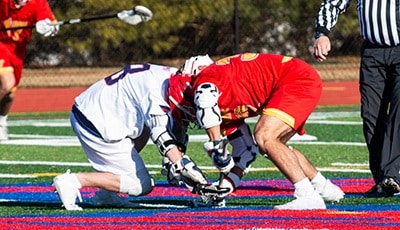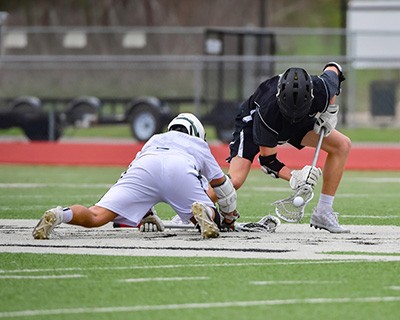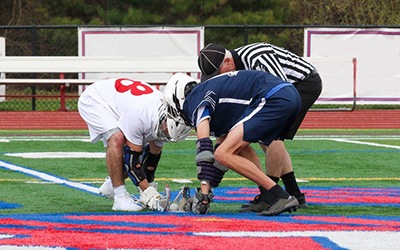Get ready to dominate the lacrosse field!
Face-offs are essential to the game and can make or break a team's success. This article will discuss the fundamentals of how to face off lacrosse and provide tips on becoming a successful player. From proper positioning and moves to practice drills and strategies – you will learn everything there is to know about facing off in lacrosse.
So let's start becoming the best lacrosse face-off player you can be!
More...
Take Away Key Points:
What is Face-off in Lacrosse?
Face-offs in lacrosse are when two players line up at the center of the field and attempt to win possession of the ball by winning control of it. The position is often referred to as FOGO, which stands for Face-Off Get-Off.
Refers need a uniform protocol to ensure fairness when the ball is put back into play after a goal or when the quarter ends.
Face-off is how they do this, giving both teams an equal shot at gaining ball control. This adds anticipation and energy to lacrosse games as one team can use momentum to their advantage and come out on top in the end.
This is usually done by crouching down low, hooking their stick against their opponent's stick, and trying to outmuscle them for control. Proper positioning and anticipation can be key in coming away with a successful face-off and gaining an advantage on the field.

The Basic Rules of Face-off
1. Before starting a lacrosse face-off, the official will place the ball on the midfield line and command both face-off guys to get down.
2. Both crosses and gloves must rest on the ground along the centerline, parallel, but not touching, the center line.
3. The hands of each player must be on their respective stick, and feet cannot touch any part of their crosse; positioning is critical, as well as alternating right and left-hand positions.
4. Once in place, an accommodation for hard-of-hearing face-off guys will be discussed before initiating play with a whistle.
5. From then on, it's all about outmuscling your opponent to gain possession of the ball.
NCAA 2020 rule change: In May 2020, the NCAA Rules Committee revamped the face-off process of Men's Lacrosse. They mandated that players begin with both feet, gloves, and sticks touching the ground while abandoning the motorcycle grip in favor of a neutral grip (alternating hand positions). Additionally, they increased enforcement of anti-clamping, which occurs when players keep the ball trapped in their stick for too long; culprits will be penalized according to NCAA and Inside Lacrosse regulations.
How to Face-off in Lacrosse?
In the fast-paced sport of lacrosse, no event is more important or exciting than a face-off.
At the beginning of each period of play and anytime a goal is scored, lacrosse teams face off to re-establish possession.
During this process, each team selects a player to serve as the face-off specialist who will attempt to win the ball cleanly.
Then two additional players are picked from the wings to give their team an edge by operating as support in the face-off circle. The key aim here is for that one player to grab hold of the ball and give their team control over it, either shooting it forward or backward.
If no possession is established, a ground battle occurs with players battling for control over the area until a team gains possession or an official signals play has restarted.
Face-off Techniques
In lacrosse, players must use the proper technique for success in the face-off. They must have only their feet set wide apart to prepare their body with even weight distribution.
They should also hold their stick tightly, grasping near the head and butt end for maximum control. As each player's athleticism and style vary, these basic principles will offer a strong foundation and improve chances of coming out on top in the face-off.
While various styles can be employed in the face-off, two popular approaches are the "clamp" and "rake" techniques.
The "clamp" technique involves clamping the stick onto the ball and pulling it closer to the body, while the "rake" involves sweeping the stick across the ground and flicking it away from an opponent.
Each approach has advantages and should be used according to each player's unique strengths.
Face-off Positioning

All players must be in their designated area when the referee blows the whistle sounds, except those in the wing areas. The other players need to get behind the restraining line.
During a face-off, nobody checking is allowed to protect the players already in a vulnerable position.
When the ground ball goes out of bounds, is crossed by the defensive-area line, or a technical foul is whistled, the face-off ends, and players outside these zones can move freely.
Face-off Violations
When it comes to face-offs in lacrosse, there are several rules and regulations that players must abide by.
Face-off violations can result in penalties or even ejection from the game. We'll explore common violations that might occur during a face-off and how referees should handle them.
1. During a face-off, players are prohibited from carrying the ball on the back of their stick.
2. Clamping the ball forward with the back of the stick is permissible, but it must be moved or directed within one step.
3. Other prohibited activities include kicking or placing any part of a player's body onto an opponent's cross.
4. Likewise, playing the ball with one's hand or fingers is not allowed and is punishable as unsportsmanlike conduct.
5. If the ball becomes caught in an opponent's crosse after the faceoff, play shall immediately stop, and possession will go to the opposing team.
6. The ball may not be trapped within its crosse for longer than necessary to control it and pick it up in a single movement.
7. Players must remain stationary once the "set" call has been initiated.
8. Any presence of tape touching the lacrosse head's plastic throat is illegal.
9. The goalkeeper is not allowed to participate in a face-off.
Lacrosse Face-off Drills & Tips to Dominate the Field
Face-off drills are an essential part of the game of lacrosse. They teach players the fundamentals of controlling the ball off the draw, including technique, positioning, and strength.
Here are some of the most effective drills you can do solo or with a coach to excel in your face-off game!
Skills Every Lacrosse Player Must Possess for Good Face-offs
Being a great face-off player in lacrosse games requires mastering several core skills.
1. Incredible speed
To become an elite face-off player in lacrosse, mastering speed is essential. Developing quick reflexes and fast hands are the first steps to winning face-offs.
In the same way, players should start with warmup drills that focus on hand-eye coordination and reaction time. "Whistle Patience" we discussed above is an excellent drill for this purpose, as it simulates the motion of a face-off without a stick.
With enough repetition and dedication, players can develop lightning-fast reflexes, giving them an advantage over their opponents during a match.
2. Using body as a weapon
To master using their body as a weapon during a lacrosse face-off, players must learn how to use their size and strength to their advantage.
Pivoting is one of the key moves, allowing you to gain an edge while still keeping the ball in front of you. Additionally, careful positioning with your feet and arms can give you leverage against opponents who are bigger or stronger than you.
Drive checks and lacrosse stick placement also help create space between you and the other player so that you can gain control of the ball.
3. Use lacrosse IQ as a leverage
Upgrading your lacrosse IQ is essential for winning. Players should work to develop a thorough understanding of their face-off position and the opposing team's strategies.
Technique and body positioning are important, but anticipating a move before it happens can be even more beneficial.
Learn when to jump, when to stay low, and how to counter each type of opponent you may face off against.
Ultimately, developing a high lacrosse IQ through studying footage of other players and analyzing situations will give you an advantage on the face-off line.
FAQs
What is a face off in girls lacrosse?
A face-off in girls' lacrosse is a method of starting each period or restarting play after a goal is scored.
The ball is placed between two players standing at either end of the center line, competing to gain control of the ball. During the draw, players use their sticks to try and scoop up the ball and move it to their offense side.
Quick reflexes, powerful lacrosse stick skills, and smart positioning are essential for lacrosse game skills! Unlike men's lacrosse, women's lacrosse face-off doesn't allow for body checks or excess physical contact.
What does FOGO mean in lacrosse?

In lacrosse, 'FOGO' is short for 'Face Off, Get Off.' This term describes winning a face-off, then transitioning back to the defensive end to give your team an advantage.
How can I practice face-offs?
Practicing face-off is essential to mastering this vital skill. To do so, you should first work on the fundamentals, such as hand positioning and stick technique.
Then, practice footwork and body position to give yourself an edge in the draw. Once you have these basics down, try doing drills with a partner or coach, such as setting up multiple draws and competing against each other for possession of the ball.
Who is the best faceoff man in lacrosse?
Some of the most renowned face-off specialists include Gerard Arceri, TD Ierlan, Kyle Gallagher, and Conor Gaffney.
How do you win face off in lacrosse?
Face-off win requires mastering the fundamentals of stick technique, hand positioning, quick footwork, and body control to out-maneuver your opponent.
Additionally, winning a face-off determines who controls the ball when play begins. When one team gains possession and wing players are let go, the face-off win is credited to that team regardless of whether or not they gain an offense opportunity from it.
Final Words
Face-offs are an important part of the lacrosse game and can be mastered with practice and dedication. Knowing the fundamentals of stick technique, left-hand positioning, footwork, and understanding how to anticipate the whistle is integral to winning draws.
By learning how to face off lacrosse, you'll be ready for any challenge on the field.
